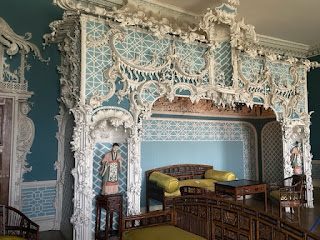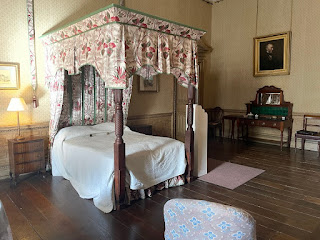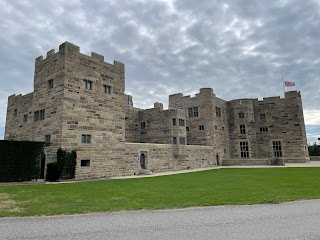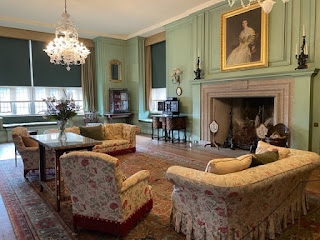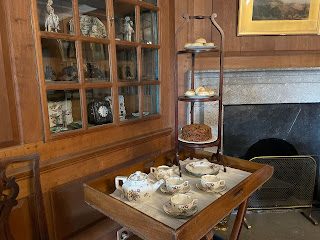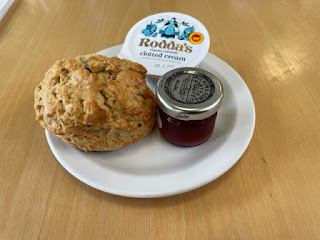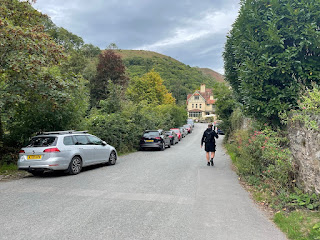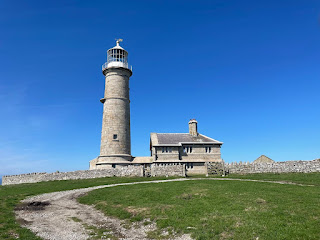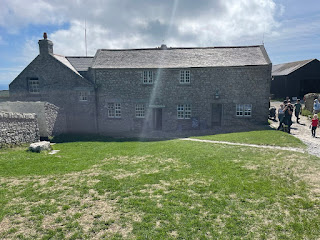Over the nine years of this project, I have discovered a category of National Trust properties that I call 'Doesn't Look Like Much From The Outside But Inside It's Amazing'. Claydon in Buckinghamshire is firmly in that category.
To be honest, I don't even know where to start with it. I'll try and begin with some of the rooms before I move on to the history of the Verney family.
The North Hall
The house was built for Ralph, the second Earl Verney, in the 1750s-1760s by Luke Lightfoot. He was a stonemason and woodcarver who had impressed Ralph with his work and it's easy to see why: all of the elaborate wall carvings you see in the terrible picture below are wood carvings by Lightfoot.
Unfortunately, Lightfoot had his limitations. The planned house was actually three times the size of what we see today - there was originally also a rotunda and a third wing. But he made mistakes in how the house was built - a respected architectural expert at the time referred to him as "an ignorant knave" - which probably resulted in the demolition of the rotunda and the other wing after only 20 years. (The demolition of the rotunda also explains why the house doesn't have a front entrance.)
During construction, it was also discovered that Lightfoot had been defrauding the Earl, and he was dismissed from the project before it was completed. (In a later court case, it was established that Lightfoot had been paid £30,000 but had only delivered £7,000 of work or goods.)
The Saloon
The sacking of Lightfoot means that there is a mixture of styles in the house. The North Hall is fully Rococo and then you walk into the Saloon, which is Palladian. It's another show-stopper of a room, however, with a huge expanse of space covered in elaborately designed fittings.
You can probably guess what's coming next: the second Earl ended up in financial ruin and in 1784 work on the house stopped. The furniture was sold to cover his debts.
The Chinese Room
I had done no real research on Claydon before I visited. If I had, I might have seen the guidebook descriptions of the Chinese Room as "the glory of Claydon" and "one of the most extraordinary rooms in any English country house".
But I hadn't seen any of that, so I unsuspectingly wandered into the upstairs room and was completely dumbfounded by it. The alcove is a show-stopping sight, with its intricate wood carvings. The rest of the room is also covered in elaborate decoration. I've never seen anything like it.
Florence Nightingale Bedroom
After the jaw-dropping ostentation of the Chinese Room, you find yourself in rooms that are much simpler in style but come with huge amounts of fascinating history.
In 1858, Sir Harry Verney married Parthenope Nightingale, the older sister of Florence. (Both women were named after their birthplaces - Parthenope being the Ancient Greek name for Naples.)
This meant that Florence spent a lot of time at Claydon from the 1860s through to 1895. There are various rooms that provide insight into her life, her former bedroom being one of them:
There's a portrait of Florence in her room that really didn't match the image I had of her in my mind, but I liked it all the more for that:
The Claydon Museum
At this point in my visit, I was sure that Claydon couldn't possibly have any more rooms that would wow me. But Claydon wasn't done and I walked into the final flourish; The Museum. It was created by Sir Harry Verney in 1893 to showcase his artefacts from around the world. I failed to get any good photos of his gamelan, a set of gongs and other instruments from Java. But I did get this picture of the case dedicated to Florence - it's a replica of the type of Turkish lamp that she would have used as a nurse in the Crimea when she became famous as the Lady with the Lamp.
Until now, I have always avoided doing 'room by room' descriptions on this blog but it really is the best way to describe the Claydon experience. To be clear, there were other rooms too - I've only shared the most awe-inspiring ones.
Anyway. Before I get to the scone, let me tell you a bit more about the Verney family:
- There have been Verneys in Buckinghamshire since the 1200s
- In around 1463, the manor of Middle Claydon was bought by one Sir Ralph Verney who had been Lord Mayor of London
- The house was leased to a Roger Giffard, who built a house on the site of today's building as well as the chancel of All Saints church that stands next to it
- In 1620, Sir Edmund Verney decided he wanted Claydon back - he bought the Giffards out of their tenancy and became the first Verney to actually live there
- Sir Edmund was a very interesting man: he had served both Charles I and his older brother, who died prematurely. When Charles acceded to the throne, Edmund was a Gentleman of the Privy Chamber.
- He was staunchly loyal to the King during the Civil War, even though he didn't agree with him. There's a lovely paragraph in the guidebook that explains his position: "I have eaten his Bread, and served him for nearly thirty Years, and will not do so base a Thing as to forsake him; and chuse rather to lose my Life (which I am sure I shall do) to preserve and defend those Things which are against my Conscience to preserve and defend."
- Edmund was right about one thing: he did lose his life. His son Ralph had sided with the Parliamentarian cause and begged his father not to get involved but Edmund ended up as the King's Standard Bearer and died at the Battle of Edgehill in 1642.
- It all gets a bit grisly in the guidebook after that: the enemy troops who killed him couldn't get the Standard from Edmund, so they hacked his hand off. That's the only bit of him that lies in his tomb in the church, as the rest of his corpse was never recovered.
- Ralph was not rewarded for siding with Cromwell. He refused to sign the Solemn League and Covenant, and had to go into exile. Claydon was sequestered.
- Ralph's wife, Lady Mary, came back to Claydon and found it in a terrible state. The house was returned to the Verneys and things improved under Charles II, with Ralph becoming the first baronet.
- His son John was very successful as 2nd baronet and became Viscount Fermanagh in 1703
- John's grandson, also Ralph, ended up as the second Earl in 1752 and it was he that built Claydon as we see it today
- Claydon is located near Stowe, another NT property, which was owned by Sir Ralph's political opponent at the time. Sir Ralph upped his spending on Claydon to compete with the splendour of Stowe. Bad move, Ralph.
- But the house wasn't Ralph's only financial mistake. He was patron to Edmund Burke, the philosopher and economist, who wrote that Ralph "suspects nothing, fears nothing, he takes no precautions, he imagines all mankind to be his friend". And Burke would know - he and his cousin William owed Ralph £71,000 between them and they never repaid it.
- Ralph died a broken man. His niece, Mary, became Baroness Fermanagh. She took on the job of sorting out Claydon, demolishing the rotunda and other wing.
- Mary died in 1810. She was the last in the ancient line of Verneys, and the title died with her too. She left the house to a half-sister who had no children, so she passed it to her cousin, Harry Calvert, who changed his name to Verney.
- He married Parthenope Nightingale after the death of his first wife
- My favourite fact of the whole day: Sir Harry was an MP and was known affectionately in Parliament as "the Member for Florence Nightingale" - I can't imagine there were many occasions in the 19th century when a man was known for being the brother-in-law of a woman more famous than him
- The sixth baronet, Sir Edmund Verney, still farms the estate and lived with his family at Claydon until quite recently
The Claydon Scone
I wasn't 100% sure that I actually needed to include Claydon in this project. The house is owned by the National Trust but the rest of the estate, including the Phoenix Kitchen cafeteria, is still owned by the family. The
Rules of the National Trust Scone Blog state that only scones baked by the National Trust are mandatory. But at this late stage of the project, I'm taking absolutely no chances of missing one.
I was the first customer in the cafeteria today, so the assistant offered to bring my scone over to my table. It turned into the opening titles of Grange Hill, except that instead of a cartoon sausage, it was a ginormous scone that suddenly appeared over my shoulder.
It is definitely the biggest scone I have encountered in my nine years on this quest. And although that was great, it also brought problems, because the jam and the cream barely stretched to cover half the scone. On the plus side, it was warm and very fresh.
I'll finish by reminding you all that, although Claydon was brilliant, there is only one National Trust property that can win the Gold Award for 'Doesn't Look Like Much From The Outside But Inside It's Amazing' and that is
Clouds Hill in Dorset. It's a tiny little hovel, basically, but it's where Lawrence of Arabia wrote his books. Both properties are highly recommended.
Claydon: 5 out of 5
Scone: 4.5 out of 5
Number of times I said "Oh my God" or heard other visitors saying it as I walked around: at least 20



